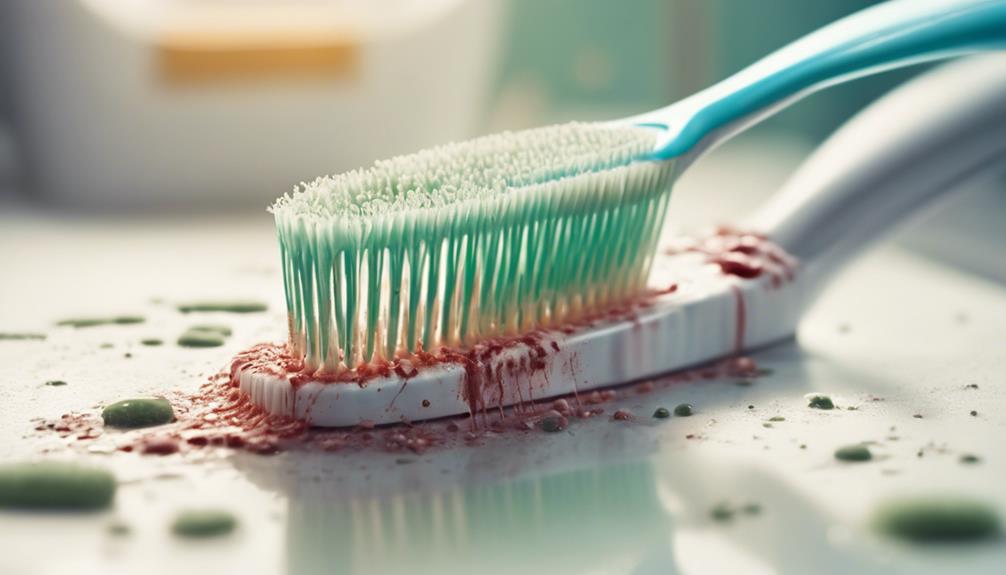Your toothbrush can be a breeding ground for up to 10 million bacteria if you don't change it every 3-4 months. These harmful germs thrive, especially in damp bathroom environments, and can transfer to your mouth, increasing the risk of oral infections and even systemic diseases. Worn bristles can't clean effectively, leading to plaque buildup and gum issues. Discoloration or an unpleasant odor are signs it's time for a new brush. Keeping up with toothbrush hygiene not only protects your teeth but also your overall health, showing there's more to this issue than meets the eye.
Key Takeaways
- Toothbrushes can harbor up to 10 million bacteria, increasing the risk of oral infections and systemic health issues.
- Worn bristles are less effective at cleaning, leading to plaque buildup and elevated risks of tooth decay and gum disease.
- Bathrooms create damp environments that promote bacterial growth on toothbrushes, making regular replacement crucial for hygiene.
- Ignoring signs of wear or discoloration on your toothbrush can result in harmful bacteria transferring to your mouth.
Importance of Regular Replacement

Regularly replacing your toothbrush is fundamental for maintaining good oral hygiene and preventing harmful bacteria from building up. Dental professionals recommend that you replace your toothbrush every 3-4 months to guarantee your toothbrush remains effective. An old toothbrush can harbor up to 10 million bacteria, which greatly increases your risk of dental issues, including infections.
If you notice worn bristles or discoloration, it's time to replace your toothbrush. Worn bristles can't clean your teeth effectively, leaving plaque behind and raising your chances of developing tooth decay and gum disease. Ignoring these signs puts your oral health at risk, as a compromised toothbrush won't remove debris and bacteria from your teeth properly.
Additionally, if you've recently recovered from an illness, it's important to get a new toothbrush. This minimizes the risk of reinfection and prevents the transmission of germs.
Understanding Bacteria Growth

Bacteria thrive on your toothbrush, turning it into a breeding ground for harmful pathogens that can jeopardize your oral health. Every time you brush, bacteria from your mouth transfer to your toothbrush, leading to a buildup that you can't see. This is why it's essential to replace your toothbrush regularly.
Here are three key reasons to take into account:
- Pathogen Accumulation: Your toothbrush can harbor around 10 million bacteria, some of which are linked to oral diseases, including decay and gum problems.
- Damp Environments: Bathrooms promote rapid bacterial growth due to moisture, making it easier for harmful bacteria to multiply on your toothbrush.
- Increased Risk: Prolonged use of the same toothbrush notably raises the risk of transferring these harmful bacteria back into your mouth, potentially leading to gum disease and further decay.
Risks of Worn Bristles

Using a toothbrush with worn bristles can seriously compromise your oral health, as frayed bristles are less effective at removing plaque and can even damage your teeth and gums. When bristles lose their stiffness, they fail to clean effectively, leading to plaque buildup and increasing your risk of gum disease.
Here's a quick look at the risks associated with using a toothbrush that's seen better days:
| Risk | Explanation |
|---|---|
| Worn Bristles | Lose effectiveness in cleaning teeth |
| Plaque Buildup | Increases risk of cavities and gum disease |
| Tooth Enamel Damage | Frayed bristles can be abrasive |
| Gum Tissue Inflammation | Improper cleaning can lead to gum irritation |
| Gum Recession | Prolonged use can cause premature gum issues |
To maintain good oral hygiene, it's essential to replace your toothbrush every three months. Ignoring worn bristles can lead to serious dental problems, so keep an eye on your brush. Don't let a simple habit jeopardize your smile!
Signs Your Toothbrush Is Old

Your toothbrush shows clear signs of aging when the bristles become frayed or bent, indicating it's time for a replacement. Ignoring these signs can compromise your cleaning routine and overall oral health.
Here are three key indicators that your toothbrush needs to go:
- Frayed or Bent Bristles: If the bristles no longer stand upright, they're less effective at removing plaque, which can lead to bacteria buildup in your mouth.
- Discoloration or Odor: A discolored toothbrush or one that emits an unpleasant smell is a red flag. This deterioration suggests bacteria are accumulating, making it essential to replace your brush.
- Loss of Cleaning Effectiveness: If you notice that your toothbrush isn't cleaning your teeth as well as it used to, it's likely time for a new one. Worn brushes can leave more plaque behind, putting your oral health at risk.
Regularly check your toothbrush and don't wait too long to replace it. By paying attention to these signs, you minimize the risk of bacteria accumulation and help maintain your oral hygiene.
Tips for Toothbrush Hygiene

To maintain ideal toothbrush hygiene, rinse it thoroughly with hot water after each use to eliminate toothpaste residues and reduce bacterial buildup. Following this simple practice sets the stage for a healthier brushing routine.
Here's a quick reference table for effective toothbrush hygiene:
| Tip | Importance | Frequency |
|---|---|---|
| Rinse after each use | Reduces bacteria and residue | Every use |
| Sanitize with hydrogen peroxide | Cuts bacterial load by up to 85% | Weekly |
| Replace your toothbrush every three months | guarantees effective cleaning and reduces bacteria | Every 3-4 months or sooner |
| Check for frayed bristles | Worn out brushes are less effective | Monthly |
| Store your toothbrush upright | Minimizes moisture and bacterial growth | Always |
Storage Best Practices

To keep your toothbrush in top shape, store it upright in a dry area.
Make sure to keep it at least three feet away from the toilet to avoid any unwanted bacteria.
Also, consider using separate containers for each family member to reduce the risk of cross-contamination.
Proper Upright Storage
Storing toothbrushes upright allows them to air dry properly, which helps reduce moisture that encourages bacterial growth.
When your toothbrush is wet and stored in a closed container, it creates the perfect environment for bacteria and germs to thrive.
To keep your toothbrush clean and prevent contamination, follow these best practices:
- Use a holder: Choose a dedicated holder for each family member's toothbrush. This keeps them separate and reduces the risk of cross-contamination.
- Position wisely: Always store your toothbrush at least three feet away from the toilet. This distance minimizes exposure to aerosolized bacteria released during flushing.
- Avoid damp conditions: Never store your toothbrush in a closed container while it's still wet. Allow it to air dry completely to prevent mold and the growth of harmful bacteria.
Avoid Shared Containers
Avoiding shared containers is essential for maintaining your toothbrush's hygiene and preventing the spread of bacteria among family members. When you store toothbrushes together, you increase the risk of cross-contamination, as germs can easily transfer from one brush to another. Each person in your household should have their own designated toothbrush holder. This simple step minimizes the chances of sharing bacteria that could harm your oral health.
It's also vital to avoid placing toothbrushes in closed containers while they're wet. Doing so creates a moist environment that bacteria thrive in, leading to potential mold growth and other hygiene issues. Instead, store your toothbrushes upright in a dry area, allowing them to air out properly.
Regular cleaning of toothbrush holders is another smart practice; it helps eliminate any lingering bacteria that may have settled there.
Keep Away From Toilets
Keeping your toothbrush at least three feet away from the toilet helps protect it from harmful bacteria that can become airborne when you flush. To guarantee good hygiene and prevent contamination, follow these storage best practices:
- Rinse your toothbrush thoroughly after each use. This helps eliminate toothpaste residue and reduces bacterial buildup.
- Store your toothbrush in an upright position. This promotes air circulation and allows it to air dry, minimizing moisture that fosters bacterial growth.
- Avoid closed containers while wet. Keeping your toothbrush in a damp environment can lead to mold and bacteria development, which you definitely want to avoid.
Impact on Overall Health

Changing your toothbrush regularly isn't just about freshening up your smile; it's essential for your overall health.
A contaminated brush can harbor millions of bacteria, increasing your risk of oral infections and potentially transmitting illnesses within your home.
Bacterial Contamination Risks
Using the same toothbrush for too long can lead to a dangerous buildup of bacteria that not only affects your oral health but can also impact your overall well-being. Contaminated toothbrushes can harbor approximately 10 million bacteria, including harmful pathogens. When you brush, bacteria from your mouth transfer to your toothbrush, and if you're not changing your toothbrush every few months, you're increasing your risk of reinfection.
Here are three key risks associated with bacterial contamination from your toothbrush:
- Gum Disease: Extended use of the same toothbrush can lead to bacterial transfer back to your teeth and gums, potentially causing gum disease.
- Oral Infections: A contaminated toothbrush can contribute to oral infections that affect not just your mouth but your overall health too.
- Systemic Illnesses: Some bacteria linked to oral health issues can enter your bloodstream, leading to serious systemic conditions.
It's a good idea to replace your toothbrush often and maintain proper hygiene. Regularly changing your toothbrush minimizes exposure to harmful bacteria, keeping your mouth—and your body—healthier. Another gross reason for toothbrush change is that old toothbrushes can become frayed and worn, making them less effective at removing plaque and bacteria from your teeth. Additionally, if you’ve been sick, it’s important to replace your toothbrush afterwards to prevent re-infection. Overall, maintaining good oral hygiene practices, including changing your toothbrush regularly, can lead to better overall health and a brighter smile.
Illness Transmission Prevention
Toothbrushes not only pose risks for oral health but also play a significant role in illness transmission, making regular replacement essential for protecting your overall health. Did you know that toothbrushes can harbor around 10 million bacteria, including harmful pathogens? That's why it's important to follow a toothbrush replacement schedule.
The CDC recommends replacing your toothbrush every 3-4 months, especially after recovering from illnesses like colds or the flu. This simple act aids in illness transmission prevention, reducing the risk of reinfection and keeping your household healthier. If you've been sick, it's necessary to replace your toothbrush immediately to avoid spreading germs to others.
Additionally, keeping toothbrushes separate and stored hygienically can help prevent cross-contamination. Contaminated toothbrushes not only jeopardize your oral hygiene practices but can also contribute to further illness.
Oral Health Connection
Oral health directly affects your overall well-being, as poor hygiene practices can lead to serious systemic diseases like heart disease and diabetes. When you neglect to care for your oral health, harmful bacteria can enter your bloodstream, triggering inflammatory responses that impact your entire body.
Here's why you should be proactive about changing your toothbrush:
- Prevent Tooth Decay and Gum Disease: An effective toothbrush regularly removes plaque and food particles, reducing the risk of tooth decay and gum issues.
- Minimize Systemic Disease Risks: By replacing your toothbrush every three months, you lower the chances of oral bacteria contributing to systemic diseases.
- Enhance Immunity: A clean toothbrush doesn't harbor millions of bacteria that can weaken your immune system, making you more susceptible to infections.
Frequently Asked Questions
Why Do You Need to Change Your Toothbrush Often?
You need to change your toothbrush often because worn bristles can't effectively remove plaque and bacteria. Regularly replacing it helps maintain your oral health, preventing gum disease and tooth decay while ensuring your smile stays bright and healthy.
Do I Really Need to Replace My Toothbrush Every 3 Months?
Yes, you really need to replace your toothbrush every three months. Worn bristles can't clean effectively, and bacteria can build up. Keeping your brush fresh helps maintain good oral hygiene and supports your overall dental health.
Is It Gross to Use the Same Toothbrush?
Using the same toothbrush is like wearing yesterday's clothes; it just doesn't feel right. It's not just gross—it's a health risk. Keep your smile fresh by swapping your brush every few months for better hygiene.
How Often Do Dentists Recommend You Change Your Toothbrush?
Dentists recommend changing your toothbrush every 3-4 months. Keep an eye on bristles; if they're frayed or worn, it's time for a replacement. Regularly updating your toothbrush helps maintain your oral hygiene effectively.
Is Switching to an Electric Toothbrush Better for Hygiene than Regular Toothbrushes?
Many dental professionals believe that electric toothbrushes truth revealed that they are more effective at removing plaque and preventing gum disease than regular toothbrushes. The oscillating movements of electric toothbrushes can reach areas that manual brushing may miss, leading to improved overall dental hygiene.
Conclusion
To summarize, regularly changing your toothbrush is essential for your dental health.
Imagine using the same brush for months—bacteria from your mouth can multiply, leading to potential infections or gum disease.
For example, a study found that individuals who replaced their toothbrushes every three months had markedly fewer cavities and healthier gums compared to those who waited longer.
Don't risk your smile; make it a habit to swap out your brush regularly for a cleaner, healthier mouth!









